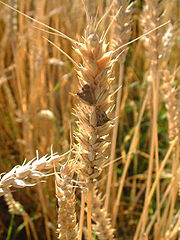
Sclerotium
Encyclopedia

Mycelium
thumb|right|Fungal myceliaMycelium is the vegetative part of a fungus, consisting of a mass of branching, thread-like hyphae. The mass of hyphae is sometimes called shiro, especially within the fairy ring fungi. Fungal colonies composed of mycelia are found in soil and on or within many other...
containing food reserves. One role of sclerotia is to survive environmental extremes. In some higher fungi such as ergot
Ergot
Ergot or ergot fungi refers to a group of fungi of the genus Claviceps. The most prominent member of this group is Claviceps purpurea. This fungus grows on rye and related plants, and produces alkaloids that can cause ergotism in humans and other mammals who consume grains contaminated with its...
, sclerotia become detached and remain dormant until a favorable opportunity for growth. Other fungi that produce sclerotia are prominent pathogens for canola
Canola
Canola refers to a cultivar of either Rapeseed or Field Mustard . Its seeds are used to produce edible oil suitable for consumption by humans and livestock. The oil is also suitable for use as biodiesel.Originally, Canola was bred naturally from rapeseed in Canada by Keith Downey and Baldur R...
crops. These and related fungi are generally controlled through the use of fungicides and crop rotation.
Sclerotia resemble cleistothecia in both their morphology and the genetic control of their development. This suggests the two structures may be homologous
Homology (biology)
Homology forms the basis of organization for comparative biology. In 1843, Richard Owen defined homology as "the same organ in different animals under every variety of form and function". Organs as different as a bat's wing, a seal's flipper, a cat's paw and a human hand have a common underlying...
, sclerotia being vestigial cleistothecia that lost the capacity to produce spores.

